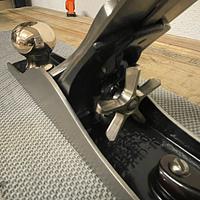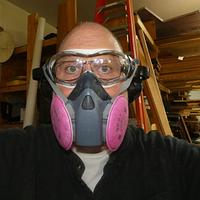Share your craft projects
Make new craft buddies
Ask craft questions
Blog your craft journey

DevinT
2746 posts
and
20 followers
in about 3 years
in about 3 years
Restorations #9: Millers Falls No 98 T-bevel gauge
This is
part 9
in a
10 part
series:
Restorations
...
-
Edlund Commercial 5-lb Premier Scale
-
Millers Falls No 98 T-bevel gauge
-
Eye carving riffler
...
- Edlund Commercial 5-lb Premier Scale
- Millers Falls No 98 T-bevel gauge
- Eye carving riffler
Purchased from eBay for $35.71 (broken down as $26.99 + tax & shipping), a 1950’s sliding bevel gauge (T-bevel) made by Millers Falls, tool No 98.
All restored:
All restored:
That is NOT how it arrived.
The way it arrived was like this:
Wrapped in a paper towel, taped to a single piece of cardboard, then tossed in a plastic bag.
Don’t be fooled into thinking that there is an optical illusion going on here — it arrived bent. However, do not be quick to blame the shippers.
I went back and examined the sellers photos very closely and if you know (based on having examined the item — shown below) what to look for, you can clearly tell it was bent before packaging. The seller said nothing about it being bent in the description, other than “look carefully at the detailed photos.”
How bent? Let’s put a number to it ..:

It (the blade, sitting on edge against a 12” Starrett rule as a straight edge reference) is a banana where a 6” Starrett measures 3/64” deviation from the two ends and the middle (shown above).
Well? Upon careful examination to individual lengths of the blade using the 6” Starrett as a reference, we can identify some problem areas. Highlighted below with a grease pencil:
That’s just one of the spots where it is bent.
I initially threw up my hands at this point and measured the blade.

It is a consistent 50-thou in thickness.
I can bend it easily with my hands and it forms easily at the anvil. So I am thinking mild steel, Parkerized.
So I could trace it out with Shaper Trace and send it over to SendCutSend in Reno to shoot lasers at some 4130 Chromoly steel (50-thou thick) and then black zinc electroplate it as a replacement, …
But I am stubborn. I like this tool, and I want to use it as it was intended, let’s try to save it.
At first I spent a good hour at the anvil with the blade and a bumping hammer directly against the metal. While this moves the metal quickly and efficiently, it doesn’t provide the best finish on the metal (my anvil has scars which impart to the steel surface).
I get it 90% flat using just the bumping hammer (square side) and the anvil.
I then test it and it’s pretty good. I definitely think I can save it at this point.
So I then work it some more but this time over a block of Walnut and using a large mallet as an interface to increase the surface area of my blows
But it is at this point that I then realize there is a twist in the blade that neither technique has addressed. As a form of desperation, I rationalize an approach on-the-spot based on what I have.
More Walnut (turning blanks; I don’t turn but my neighbor gave me a bunch of blanks when he moved), and clamps. I figured there would be no harm in clamping up and wailing on the twist. That looked like this …
When I popped that out of the clamps, it came out 99% straight. The twist was gone though. That was astonishing!
A glutton for punishment, I then went back to using just the bumping hammer (this time round side) and worked it once, and checked it. We slid back to about 85% flat. Whoops! Flipped it, used lighter taps, and worked it once, twice, and checked it.
Ninja! 100% straight! So straight I could not tell it was ever bent.
At this point I figured, hey, we haven’t spent enough time on this (only 4 hours) so let’s go ahead and polish the hardware and wax the wood. Before we do that, let us admire the straightness.
Seeing that alleviated all my anger toward the seller. Surprised myself; didn’t think that was going to be possible to get such good results. Got to put the cherry on top now.
Blarg, that bolt needs a touch of polish.
90 seconds later (I timed it):
So dry, this wood needs some wax. My favorite wax: Daddy Van’s with Lavendar

The wax gave it a rich look (below)
Which brings us to the “medallion” (the knurled screw that tightens the wooden body around the blade to lock the desired angle).
Which leaves us only with applying some paste wax to the blade and then putting it back together
There is one thing I did not film/photo.
The thing did not close all the way. I took a diamond file to the end and fixed that. Except it was taking too long so I then hollow ground the end with a hand crank grinding wheel, then used the diamond plate to take the hollow out. Closed beautifully now.
I love this thing now.
5 Comments
nice bevel, a tool that should be in every woodworkers tool chest !
working with my hands is a joy,it gives me a sense of fulfillment,somthing so many seek and so few find.-SAM MALOOF.
Nice write up!
Ryan/// ~sigh~ I blew up another bowl. Moke told me "I made the inside bigger than the outside".
Nice restoration Devin!
Love the older style (hate any with a stupid wing nut versus what you show)
.
I always thought those blades were spring steel, but still you rock for the efforts to remove that bend!
I wonder, if those issues were not actual kinks, if tempering for a while in the oven might have let it return to zero.
.
I always thought those blades were spring steel, but still you rock for the efforts to remove that bend!
I wonder, if those issues were not actual kinks, if tempering for a while in the oven might have let it return to zero.
Nice save Devin, looks great.



















































